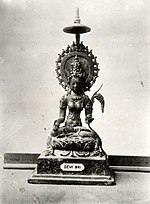
The Ramayana also known as Valmiki Ramayana, as traditionally attributed to Valmiki, is a smriti text from ancient India, one of the two important epics of Hinduism known as the Itihasas, the other being the Mahabharata. The epic narrates the life of Rama, a prince of Ayodhya in the kingdom of Kosala. The epic follows his fourteen-year exile to the forest urged by his father King Dasharatha, on the request of Rama's stepmother Kaikeyi; his travels across forests in the Indian subcontinent with his wife Sita and brother Lakshmana; the kidnapping of Sita by Ravana, the king of Lanka, that resulted in war; and Rama's eventual return to Ayodhya along with Sita to be crowned king amidst jubilation and celebration.

Lakshmana, also spelled as Laxmana, is the younger brother of Rama and his loyalist in the Hindu epic Ramayana. He bears the epithets of Saumitra and Ramanuja. He is the twin of Shatrughna.
Old Javanese or Kawi is the oldest attested phase of the Javanese language. It was spoken in the eastern part of what is now Central Java and the whole of East Java, Indonesia. As a literary language, Kawi was used across Java and on the islands of Madura, Bali, and Lombok. It had a sizable vocabulary of Sanskrit loanwords but had not yet developed the formal krama language register, to be used with one's social superiors that is characteristic of modern Javanese.
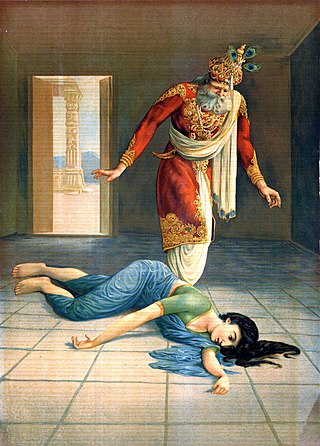
Dasharatha was the king of the Kosala kingdom and a scion of the Suryavamsha dynasty in Hinduism. He ruled from his capital at Ayodhyā. Dasharatha had three primary consorts: Kausalya, Sumitra, and Kaikeyi, and from these unions were born Rama, Bharata, Lakshmana, and Shatrughna. He is mentioned in the Rāmāyana epic and the Vishnu Purana.

Hayam Vuruk (1334–1389), also called Rajasanagara, Pa-ta-na-pa-na-wu, or Bhatara Prabhu after 1350, was a Javanese Hindu emperor from the Rajasa dynasty and the 4th emperor of the Majapahit Empire. Together with his prime minister Gajah Mada, he reigned the empire at the time of its greatest power. During his reign, the Hindu epics, the Ramayana and the Mahabharata, became ingrained in the culture and worldview of the Javanese through the wayang kulit. He was preceded by Tribhuwana Wijayatunggadewi, and succeeded by his son-in-law Wikramawardhana.
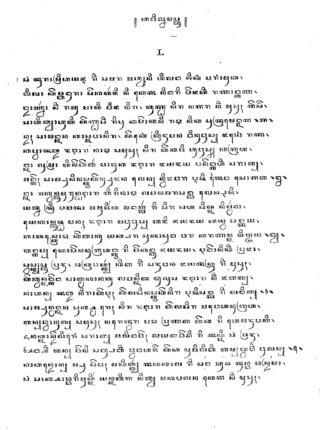
Kakawin Bhāratayuddha is an Old Javanese poetical rendering of some books (parva) of the Mahabharata by Mpu Sedah and his brother Mpu Panuluh in Indian meters. The commencement of this work was exactly 6 November 1157 by Sedah, and finished by Panuluh. The year of the composition is given in a chronogram sanga-kuda-śuddha-candramā which gives the year 1079 Saka. This is the equivalent of 1157 AD. Bhāratayuddha means "India's War" or "War of Bharat".

Bharatayuddha or Bharat Yudha is a term used in Indonesia for the Kurukshetra War, and to describe the Javanese translation and interpretation of the Mahabharata. The Mahabharata was translated into (old) Javanese under the reign of king Dharmawangsa of Medang. The current poem was started by Sedah in 1157, and finished by mpu Panuluh. Mpu Panuluh also wrote the Kakawin Hariwangsa.

Sita, also known as Siya, Janaki, Maithili, Vaidehi and Bhumija, is a Hindu goddess and the female protagonist of the Hindu epic, Ramayana. She is the consort of Rama, the avatar of the god Vishnu, and is regarded as an avatar of Vishnu's consort, Lakshmi. She is also the chief goddess of Rama-centric Hindu traditions. Sita is known for her dedication, self-sacrifice, courage, and purity.
Kakawin are long narrative poems composed in Old Javanese, also called "Kawi", written in verse form with rhythms and meters derived from Sanskrit literature. Poets used a formalized literary language, rather than the vernacular. Poets composed and performed the poems at the courts of central and east Java kings between the 9th and 16th centuries, and in Bali.

Wayang wong, also known as wayang orang, is a type of classical Javanese and Balinese dance theatrical performance with themes taken from episodes of the Ramayāna or Mahabharāta. Performances are stylised, reflecting Javanese court culture:
Wayang wong dance drama in the central Javanese Kraton of Yogyakarta represents the epitome of Javanese aesthetic unity. It is total theatre involving dance, drama, music, visual arts, language, and literature. A highly cultured sense of formality permeates every aspect of its presentation.
Hikayat Seri Rama is the Malay literary adaptation of the Hindu Ramayana epic in the form of a hikayat. The main story remains the same as the original Sanskrit version but some aspects of it were slightly modified to a local context such as the spelling and pronunciation of names. Numerous branch stories had also been developed as accretions to or extensions of this epic with the upgrading of minor characters to major ones, or the invention of totally new characters. For example, Malay writers and storytellers have produced variations in which Laksmana (Lakshman) plays a larger role, sometimes becoming more important than Rama the elder prince much like the Lao Phra Lak Phra Lam. Rama, although righteous and virtuous, was perceived to be weak and his character is often moved to the background while the younger Laksmana is admired for his courage and willingness to react decisively.

Kakawin Sutasoma is an Old Javanese poem in poetic meters. It is the source of the motto of Indonesia, Bhinneka Tunggal Ika, which is usually translated as Unity in Diversity, although it means '(Although) in pieces, yet One'. It is not without reason that the motto was taken from this kakawin as the kakawin teaches religious tolerance, specifically between the Hindu and Buddhist religions.
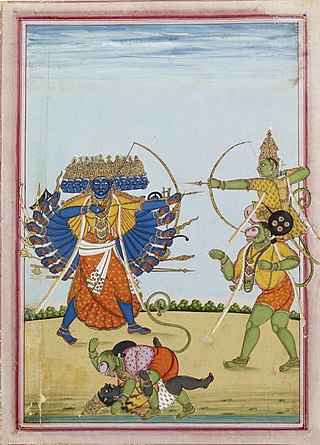
Depending on the methods of counting, as many as three hundred versions of the Indian Hindu epic poem, the Ramayana, are known to exist. The oldest version is generally recognized to be the Sanskrit version attributed to the sage Narada, the Mula Ramayana. Narada passed on the knowledge to Valmiki, who authored Valmiki Ramayana, the present oldest available version of Ramayana.

Bala Kanda is the first Book of the Valmiki Ramayana. The Bala Kanda, in part—if not in its entirety—is generally regarded as an interpolation to the original epic.
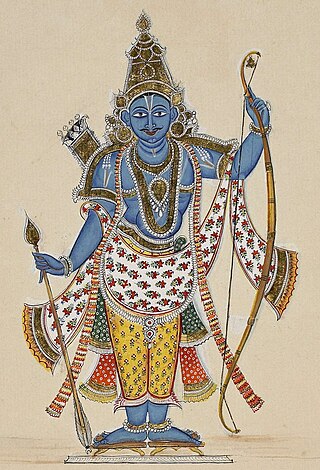
Rama is a major deity in Hinduism. He is the seventh and one of the most popular avatars of Vishnu. In Rama-centric traditions of Hinduism, he is considered the Supreme Being.
Bhaṭṭikāvya is a Sanskrit-language poem dating from the 7th century CE, in the formal genre of the "great poem" (mahākāvya). It focuses on two deeply rooted Sanskrit traditions, the Ramayana and Panini's grammar, while incorporating numerous other traditions, in a rich mix of science and art, poetically retelling the adventures of Rama and a compendium of examples of grammar and rhetoric. As literature, it is often considered to withstand comparison with the best of Sanskrit poetry.
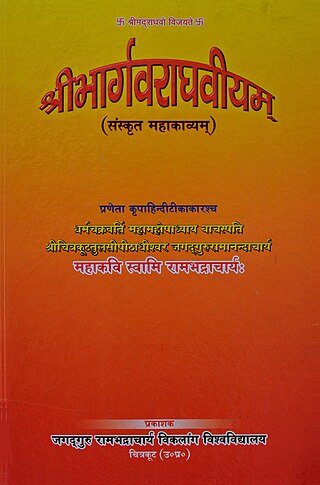
Śrībhārgavarāghavīyam (2002), literally Of Paraśurāma and Rāma, is a Sanskrit epic poem (Mahākāvya) composed by Jagadguru Rambhadracharya (1950–). It consists of 2121 verses in 40 Sanskrit and Prakrit metres and is divided into 21 cantos (Sargas) of 101 verses each. The epic is the narrative of the two Rāma Avatars – Paraśurāma and Rāma, which is found in the Rāmāyaṇa and other Hindu scriptures. Bhārgava refers to Paraśurāma, as he incarnated in the family of the sage Bhṛgu, while Rāghava refers to Rāma as he incarnated in the royal dynasty of king Raghu. For the work, the poet was awarded the Sahitya Akademi Award for Sanskrit in 2005, and several other awards.

Javanisation or Javanization is the process in which Javanese culture dominates, assimilates, or influences other cultures in general. The term "Javanise" means "to make or to become Javanese in form, idiom, style, or character". This domination could take place in various aspects; such as cultural, language, politics and social.

Trijata is a rakshasi (demoness) in the Hindu epic Ramayana who is assigned the duty of guarding Sita who was kidnapped by the demon-king of Lanka Ravana. In later adaptions of Ramayana, Trijata is described as a daughter of Vibhishana, the brother of Ravana.

Kawaca is a term for war attire mentioned in Old Javanese texts. Its name comes from the Sanskrit kawaca which means armor, cuirass, a type of chain mail, any kind of cover, corset, jacket.

